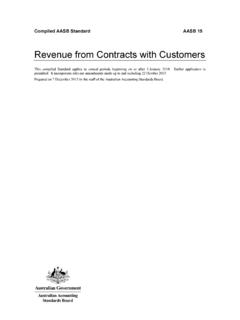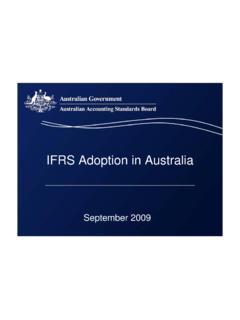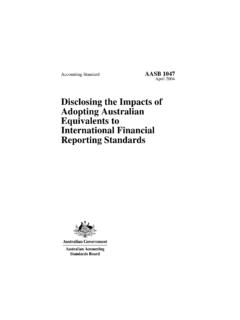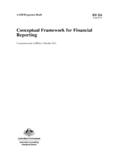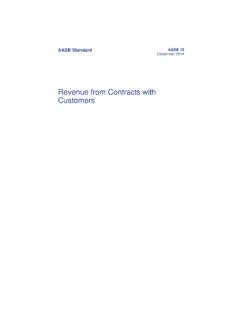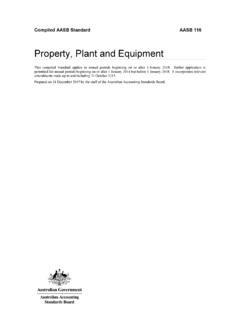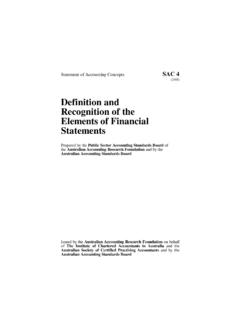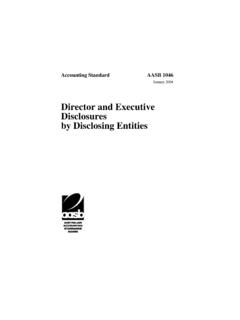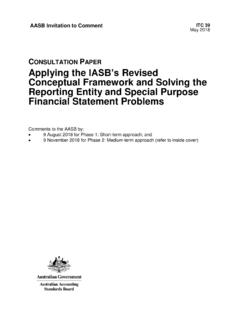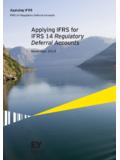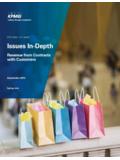Transcription of AASB IFRS Based Standard
1 AASB Standard AASB 9. December 2014. Financial Instruments Obtaining a Copy of this Accounting Standard This Standard is available on the AASB website: Alternatively, printed copies of this Standard are available for purchase by contacting: The Customer Service Officer Australian Accounting standards Board Postal address: Level 7 PO Box 204. 600 Bourke Street Collins Street West Melbourne Victoria Victoria 8007. AUSTRALIA AUSTRALIA. Phone: (03) 9617 7637. Fax: (03) 9617 7608. E-mail: Website: Other Enquiries Phone: (03) 9617 7600.
2 Fax: (03) 9617 7608. E-mail: COPYRIGHT. Commonwealth of Australia 2014. This AASB Standard contains ifrs Foundation copyright material. Reproduction within Australia in unaltered form (retaining this notice) is permitted for personal and non-commercial use subject to the inclusion of an acknowledgment of the source. Requests and enquiries concerning reproduction and rights for commercial purposes within Australia should be addressed to The Director of Finance and Administration, Australian Accounting standards Board, PO Box 204, Collins Street West, Victoria 8007.
3 All existing rights in this material are reserved outside Australia. Reproduction outside Australia in unaltered form (retaining this notice) is permitted for personal and non-commercial use only. Further information and requests for authorisation to reproduce for commercial purposes outside Australia should be addressed to the ifrs Foundation at ISSN 1036-4803. AASB 9 2 COPYRIGHT. CONTENTS. PREFACE. COMPARISON WITH ifrs 9. INTRODUCTION TO ifrs 9. (available on the AASB website). ACCOUNTING Standard . AASB 9 FINANCIAL INSTRUMENTS.
4 Paragraphs Chapter 1 Objective and application Commencement Chapter 2 Scope Chapter 3 Recognition and derecognition Initial recognition Regular way purchase or sale of financial assets Derecognition of financial assets Transfers that qualify for derecognition Transfers that do not qualify for derecognition Continuing involvement in transferred assets All transfers Derecognition of financial liabilities Chapter 4 Classification Classification of financial assets Option to designate a financial asset at fair value through profit or loss Classification of financial liabilities Option to designate a financial liability at fair value through profit or loss Embedded derivatives Hybrid contracts with financial asset hosts Other hybrid contracts Reclassification Chapter 5 Measurement Initial measurement Subsequent measurement of financial assets AASB 9 3 CONTENTS.
5 Subsequent measurement of financial liabilities Amortised cost measurement Financial assets Impairment Recognition of expected credit losses Simplified approach for trade receivables, contract assets and lease receivables Measurement of expected losses Reclassification of financial assets Gains and losses Investments in equity instruments Liabilities designated as at fair value through profit or loss Assets measured at fair value through other comprehensive income Chapter 6 Hedge accounting Objectives and scope of hedge accounting Hedging instruments Qualifying instruments Designation of hedging instruments Hedged items Qualifying items Designation of hedged items Qualifying criteria for hedge
6 Accounting Accounting for qualifying hedging relationships Fair value hedges Cash flow hedges Hedges of a net investment in a foreign operation Accounting for the time value of options Accounting for the forward element of forward contracts and foreign currency basis spreads of financial instruments Hedges of a group of items Eligibility of a group of items as the hedged item Designation of a component of a nominal amount Presentation Nil net positions AASB 9 4 CONTENTS. Option to designate a credit exposure as measured at fair value through profit or loss Eligibility of credit exposures for designation at fair value through profit or loss Accounting for credit exposures designated at fair value through profit or loss Chapter 7 Effective date and transition Effective date Transition Transition for classification and measurement (Chapters 4 and 5) Transition for hedge accounting (Chapter 6) Entities that have applied AASB 9 (December 2009).
7 Or AASB 9 (December 2010) early Appendices: A. Defined Terms Page 66. B. Application Guidance Page 74. DELETED ifrs 9 TEXT Page 207. IMPLEMENTATION GUIDANCE ON ifrs 9. (available on the AASB website). BASIS FOR CONCLUSIONS ON ifrs 9. (available on the AASB website). Australian Accounting Standard AASB 9 Financial Instruments is set out in paragraphs and Appendices A and B. All the paragraphs have equal authority. Paragraphs in bold type state the main principles. Terms defined in Appendix A are in italics the first time they appear in the Standard .
8 AASB 9 is to be read in the context of other Australian Accounting standards , including AASB 1048 Interpretation of standards , which identifies the Australian Accounting Interpretations. In the absence of explicit guidance, AASB 108 Accounting Policies, Changes in Accounting Estimates and Errors provides a basis for selecting and applying accounting policies. AASB 9 5 CONTENTS. PREFACE. Introduction The Australian Accounting standards Board (AASB) makes Australian Accounting standards , including Interpretations, to be applied by: (a) entities required by the Corporations Act 2001 to prepare financial reports.
9 (b) governments in preparing financial statements for the whole of government and the General Government Sector (GGS); and (c) entities in the private or public for-profit or not-for-profit sectors that are reporting entities or that prepare general purpose financial statements. AASB 1053 Application of Tiers of Australian Accounting standards establishes a differential reporting framework consisting of two tiers of reporting requirements for preparing general purpose financial statements: (a) Tier 1: Australian Accounting standards ; and (b) Tier 2: Australian Accounting standards Reduced Disclosure Requirements.
10 Tier 1 requirements incorporate International Financial Reporting standards (IFRSs), including Interpretations, issued by the International Accounting standards Board (IASB), with the addition of paragraphs on the applicability of each Standard in the Australian environment. Publicly accountable for-profit private sector entities are required to adopt Tier 1 requirements, and therefore are required to comply with IFRSs. Furthermore, other for-profit private sector entities complying with Tier 1. requirements will simultaneously comply with IFRSs.
